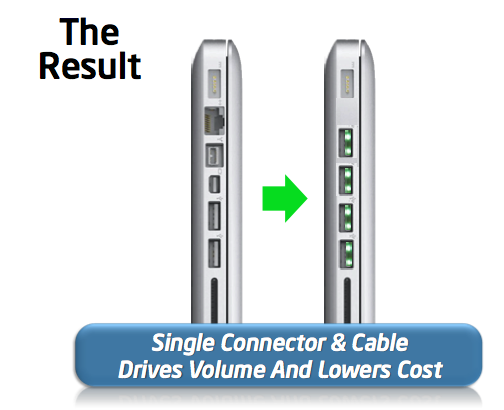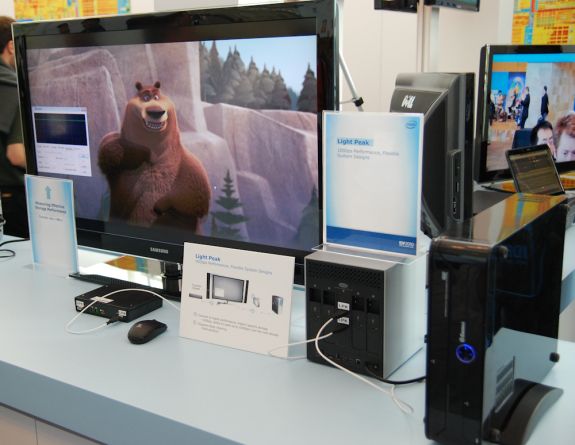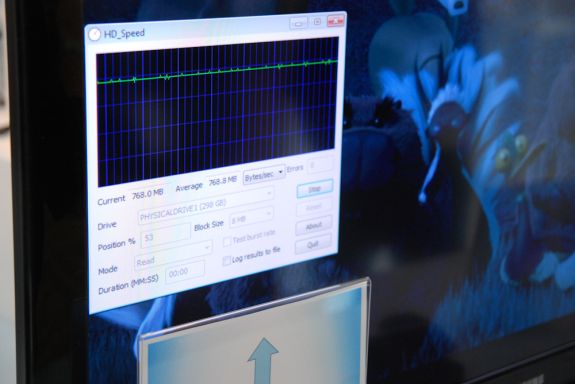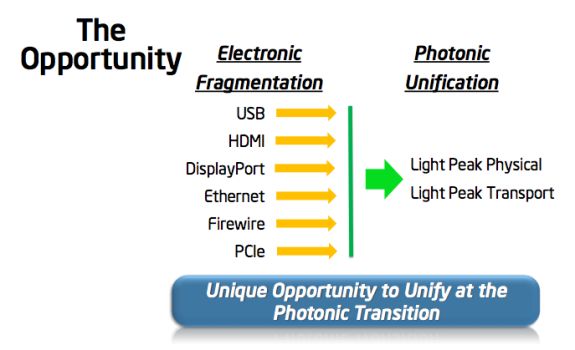Intel Light Peak - Lighting up 10 Gbps links in 2011
by Brian Klug on September 16, 2010 3:40 PM EST- Posted in
- Trade Shows
- Intel
- LightPeak
The second demo involved a desktop PC with Light Peak connecting to a modified LaCie 4big Quadra, daisy chained to another display with a built in HDMI adapter. Note that Light Peak supports daisy chaining as this demo was connected, but also supports a star topology like USB does.
At the far left on the TV was the total bitrate of the storage system, which showed a solid 768.8 megabytes/s of throughput. That's 6.15 gigabits per second of throughput. Obviously the video must have been uncompressed to achieve such high bitrate, but the display itself was only 1080P.
Both of these demos really show how close Intel is to finalizing Light Peak for consumer consumption, and how closely they've been working with partners like Western Digital and Avid for having devices ready eventually.
Obviously USB will live on for years, and USB 3.0 still isn't completely ubiquitous, but the allure of using a single connection and cable for everything sometime in the future is hard to pass up.
The Tech
I spoke with Jason Ziller - Intel's director of Optical I/O planning - about what's left for Light Peak before we can all start enjoying one superfast desktop connection. Availability was originally slated to be Q4 2010, that date has now slipped to sometime inside 2011.

Remember that USB-like port? It actually is USB, but that's only for ease of testing until Light Peak's new connector is finalized. The connector won't look like USB, and obviously will have something unique to mitigate both alignment and potential damage to the interface. Intel isn't ready to say what this looks like, but obviously the connector will be subject to the same kind of scrutiny that USB was for durability and consumer friendliness.
Light Peak isn't a protocol, but instead simply provides a new physical layer for existing connector protocols. Traffic like DVI-D, HDMI, USB, and audio can all coexist across Light Peak.
Intel didn't need to use WDM (Wavelength Division Multiplexing) to achieve 10 Gbps as demonstrated, and maintains that although WDM could be used in the future to increase bandwidth, there are other ways to scale to 100 Gbps. Currently Light Peak is 100 meters capable, though the actual product will be 50 meters of distance. Cables have sufficiently small bend radius that they can be wrapped in a knot or around a pencil without the connection losing connectivity, and up to 7 devices can be daisy chained.
Interestingly, Intel is using an 850 nm wavelength laser for the system, and (unsurprisingly) multimode fiber. Data is bidirectional across the interface as well. 850 nm is a rather interesting choice, as it's still subject to class 1 eye safety limits (just above -4 dBm), but moreso because it was the wavelength used in some of the world's very first long haul fiber optic networks.
Intel's silicon photonics remain a separate project from Light Peak, as Light Peak uses VCSEL laser diodes. The long term vision is to eventually bring the two together in a much broader scope to bridge datacenters together instead of just desktops.
There's a lot of potential for the future of desktop optical interfaces - Intel just has to deliver them. Let's hope it happens in 2011 as promised!













59 Comments
View All Comments
JoKeRr - Thursday, September 16, 2010 - link
wouldn't be surprised if Apple drove the whole lightpeak initiative as the technology choice here makes no sense.why would intel use VCSEL laser? those usually have good linewidth characteristics but a lot more expensive than DFBs and other cheaper types. For 10Gbps, you can easily directly modulate a DFB and get good reach. I suspect with VCSEL laser, there's a need for an external modulator which makes it a lot more expensive. Also on the topic of WDM, right now ppl are doing >40Gbps and 100Gbps with single wavelength, going wdm with 10gig is just a bad choice. The use of multimode fiber is not the best either. Corning already has bendable (very tight radius) single mode fiber, going multimode just create extra problems with modal dispersion and definitely requires a better receiver -> more expensive.
ya smells like a bad apple to me.
name99 - Thursday, September 16, 2010 - link
Hmm. So let me get this right.You hate the choice of a VCSEL laser because DFB would be cheaper (but not as good tech).
And you hate the choice of multimode even though IT is cheaper than single mode, because it is not as good tech.
Why not just come out straight and say that you hate this because it was spearheaded by Apple, nothing to do with the details of the tech, you just hate anything associated with Apple? Don't waste our time with your pseudo-scientific teardown of the tech when those details have fsckall to do with your actual feelings.
JoKeRr - Friday, September 17, 2010 - link
I actually work in optical communication industry and I build optical modems. Yes DFB is cheaper than VCSEL mainly b/c it's been around a lot longer and the manufacturing process is a lot more refined. Multimode is actually quite a bit more expensive than single mode, simply b/c it needs more glass. Ask anyone from corning if you don't believe me. I never said multimode is cheaper, I did say a more expensive receiver is required if you use multimode fiber. So essentially every component choice made in Light Peak is expensive. Is that enough to convince you or your ego?As to RaynorWolfcastle's comment, connector alignment with SMF is really no issue with the standardization of SC or FC connector, and the bendable single mode fiber is still cheaper than the equivalent multimode. Only real problem is keeping the SMF core clean to get enough signal sensitivity.
RaynorWolfcastle - Thursday, September 16, 2010 - link
Intel uses directly modulated VCSELs, though I can't remember where I read this (Light Reading, maybe?). I believe that VCSELs are also more die-space efficient than DFBs since they have (by definition) a vertical cavity vs the DFB's horizontal cavity.Secondly, it is very obvious that they would want multimode fiber for easier alignment and cheaper connectors. Dispersion is not really a concern over such short distances (tens of meters) anyways. Corning's photonic crystal fiber is also expensive.
You're really looking at this from a performance point of view instead of looking at it from a cost-reduction point of view. They're not looking to generate clean PSK signals over kms of fiber here, they want cheap connectors with cheap cables that can be used without any fuss by a sexagenarian.
As an aside, I really think the connector issue is a much bigger one than the article lets on. Making connectors that align well for pennies will be challenging.
DigitalFreak - Thursday, September 16, 2010 - link
"A whole article on Light Peak and nothing related to Apple?"Waaaaaaa
Stahn Aileron - Thursday, September 16, 2010 - link
No offense, but was the author half-asleep while writing this? I see many grammar errors in this piece...Frankly, the writing in this article is lower than what I usually see and expect from Anandtech."All together, the vision is enabling creation enabling the Compal notebook to control mixing on the Avid HD I/O box."
"All total, Light Peak carried uncompressed audio mixed..."
Brian Klug - Thursday, September 16, 2010 - link
I actually was half asleep, around 1:00 AM ;)Fixing those now!
-Brian
numberoneoppa - Thursday, September 16, 2010 - link
Haha, Brian. <3SteelCity1981 - Thursday, September 16, 2010 - link
So this is why Intel has kept putting native USB 3.0 support on the back burner.Roland00 - Thursday, September 16, 2010 - link
In theory it can work. But what are the chances of this causing an aftermarket vendor to make external video cards? This would be great both for laptops (so you can have battery life and speed when you need) and make it less scary for people to upgrade their video cards in their desktops.